Future? No Thanks! has a trailer and a Steam page. It’s Molleindustria’s most ambitious project to date. Production started on January 2021 as soon as it became clear that the elections weren’t going to be overthrown. It was meant to be a project for the sleepy Biden era, during which thinking about about a better future didn’t seem like a luxury. It expanded in scope and size, eventually spilling over the current dystopia-in-progress.
I still think it’s imperative to envision radical alternatives to the present, but I also worry that as things get worse every day, an ecosocialist utopia it may be perceived as an escapist fantasy or as a What-if-Bernie-won alternate reality. Anyhow, in the next year or so I’ll be trying to finish the damn thing while also humiliating myself on social media to promote it.
If you are reading this, you should wishlist the game on Steam to feed the algorithms.
You can follow its progress on Bluesky and on abominable platforms like Instagram and TikTok. Who knows? Maybe I’ll become a wretched YouTuber too.
Molleindustria Twitter Archive
Molleindustria is officially and primarily on BlueSky.
The Twitter account will remain active for the time being. In addition to it there is a searchable static archive of Tweets from 2010 to 2022 (that is until Musk’s takeover). Experience the best possible Twitter.
Meet me at the Workers’ Club
Meet me at the Workers’ Club is an interactive reconstruction of Alexander Rodchenko’s Workers’ Club. The original installation was created in 1925 to represent the Soviet Union at the Paris World Expo (aka International Exhibition of Modern Decorative and Industrial Arts).
The interactive experience offers plenty of commentary on the original pieces, on the historical context, and on Rodchenko’s work, so I won’t spoil it here.
Meet me at the Workers’ Club was made in one week in occasion of the Fuck Capitalism Jam and as a complementary piece to KLUB WRKR, a traveling art exhibition reimagining Workers’ Club today.
Play it here on a computer browser (10 minutes)
The New York Times Simulator – Release Notes
The New York Times Simulator is out now, free to play from any browser. It works decently on mobile too.
It’s a meta news game about how corporate media manufacture consent for genocide, minimize police misconduct, and serve the ruling class.
The content of the game is literally “ripped from the headlines” in that it uses mostly real headlines (and even actual edits) from the NYT, the Wall Street Journal, and other “liberal” mainstream media. I originally wanted to make parody headlines but I just couldn’t come up with anything more shameless and contrived than what’s already out there.

The indie connoisseurs will immediately recognize the similarities with Lucas Pope’s The Republia Times. The NYT Simulator is basically a modern remake that replaces totalitarian censorship with the “propaganda model” of Western corporate media, as described by Chomsky and Herman in Manufacturing Consent.
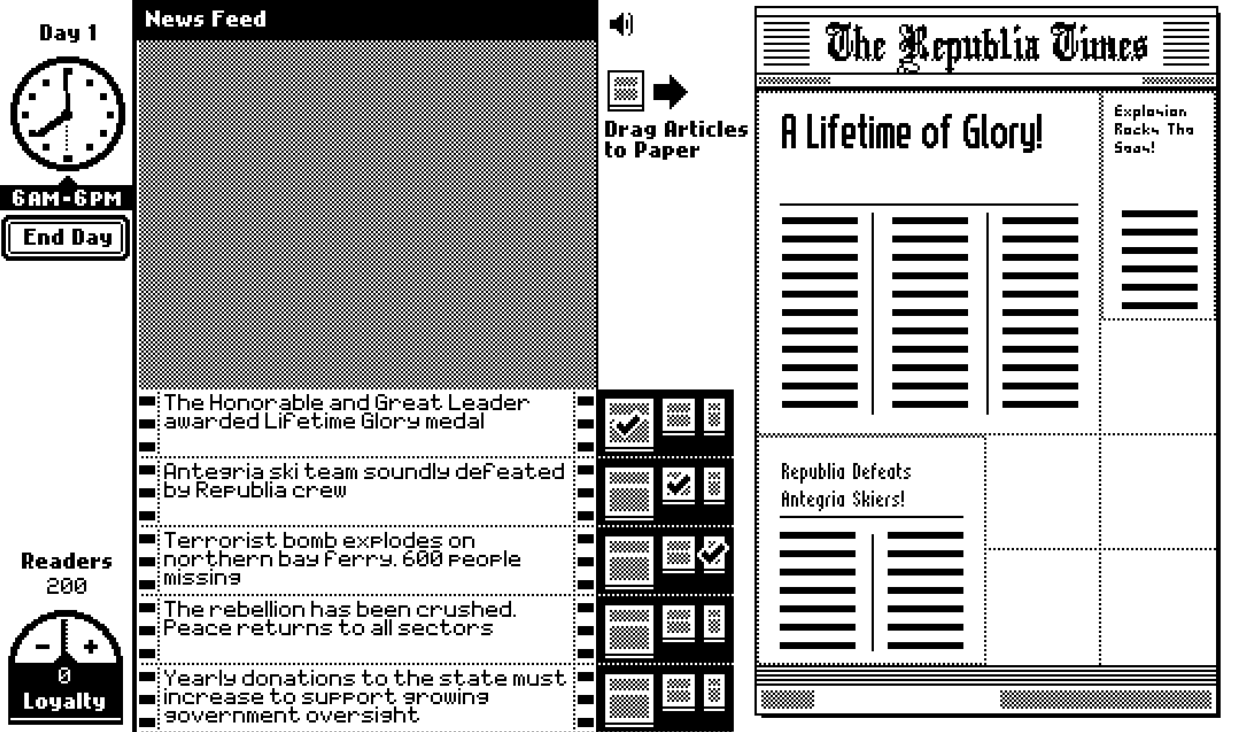
Instead of a turn-based narrative puzzle, you have a real-time gameplay more reflective of online publishing in the 24 hour news cycle. Instead of one power to propagandize, you have three interest groups you are trying to not piss off. Like in The Republia Times, Reigns, and the Democratic Socialism Simulator, the effects of your actions aren’t explicit. The variables affecting the approval are hidden, so you have to make educated guesses – meaning you have to interpret the headlines in relation to the interests of the police, Israel, and the capitalist class.
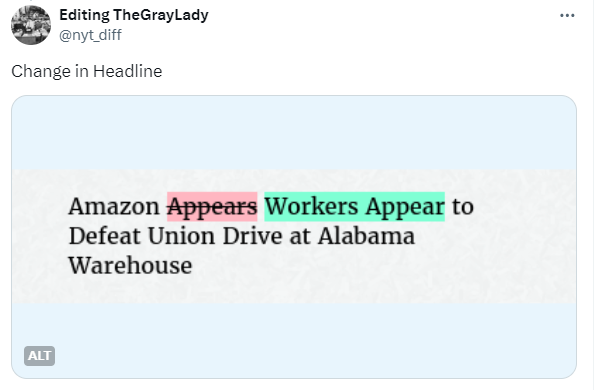
Whether you play the game “cynically” or try to do your best without getting fired, I’m hoping The New York Times Simulator can train players to quickly identify common spinning and framing techniques like the infamous passive voice (children “found dead” in Gaza), weasel words, or biased euphemisms (“officer-involved shooting”).

Headlines are important. Notoriously most people only read the headlines, and things only got worse with social media becoming the primary way to get news. It turns out that even when the full article is read, the headline dramatically condition how the information is interpreted and retained.
If you want to know if a headline in the game is real or made up, or what was the reasoning behind its inclusion, you can check out the links next to each news item in the game data.
Public game data
I managed to put together this spreadsheet very quickly thanks to media watchdogs like FAIR.org, and NYT diffs, (which tracks post-publication edits of major outlets). I’m also thankful to the thousands of individuals holding media into account every day on social media.
Of course, the danger of relying on mainstream Western media is to reproduce the same omissions. For example The New York Times has devoted almost zero coverage to Palestine Action which accomplished newsworthy results including the permanent shutdown of entire weapon factories. You also won’t hear more graphic details like the story of the Palestinian child carrying the body of his 5 year old brother in a blood-soaked backpack.
As I final note, I realize how the media’s role in cheerleading a genocide may not be the most urgent aspect of the conflict, but it’s the only the aspect I felt I could turn into a game. It’s hard to do satire and moral role-play in the face of unspeakable horrors. I hope a ceasefire will make this game dated very soon, but until then, I’ll try to update the news database to keep the game timely.
Green New Deal Simulator – Release Notes
The Green New Deal Simulator is out and free to play on all the main operating systems.
It’s a spiritual sequel of the Democratic Socialism Simulator, in that they share the same visual style, simple drag-and-drop interactions, and short-term practical utopianism.
When it comes to climate change, we are well past the “raising awareness” phase of the discourse; we need culture that raises awareness of the solutions, which are:
1) technological, infrastructural, and cultural
2) already available (at least to all the industrialized nations) and
3) inevitably threatening the existing economic and political powers.
I wanted the GND Simulator to be an accessible, almost child-friendly, catalog of these solutions and their challenges.
Even if climate change is a global issue, I was aiming for a certain geographic specificity. There are several recent games representing climate issues in a proactive, utopian, and systemic way. Half-Earth Socialism posits a global ecosocialist revolution as a prerequisite for a just energy transition; Beecarbonize abstracts a wide range of policies that the player implements as an undefined, global, collective consciousness; Terra Nil postpones ecosystem restoration to a post-apocalyptic and possibly post-human, future.
To be clear, these are all excellent titles, but I felt the need to tackle climate change as something that has to be done right here, right now, and without the need of entirely new political and economic structures. There is a chance we won’t bring down capitalism in the next 20 years or so, and that’s the timeframe we have to avoid irreversible environmental damage.
The original plan was to have three scenarios: USA, Europe, and China, with slightly different mechanics pointing at the different degrees of state agency. It turned out to be too complicated for the time I allocated, but there may be expansions if there is enough interest. Besides, the United States is the biggest emitter, historically and cumulatively speaking, and arguably the most politically resistant to climate policies.
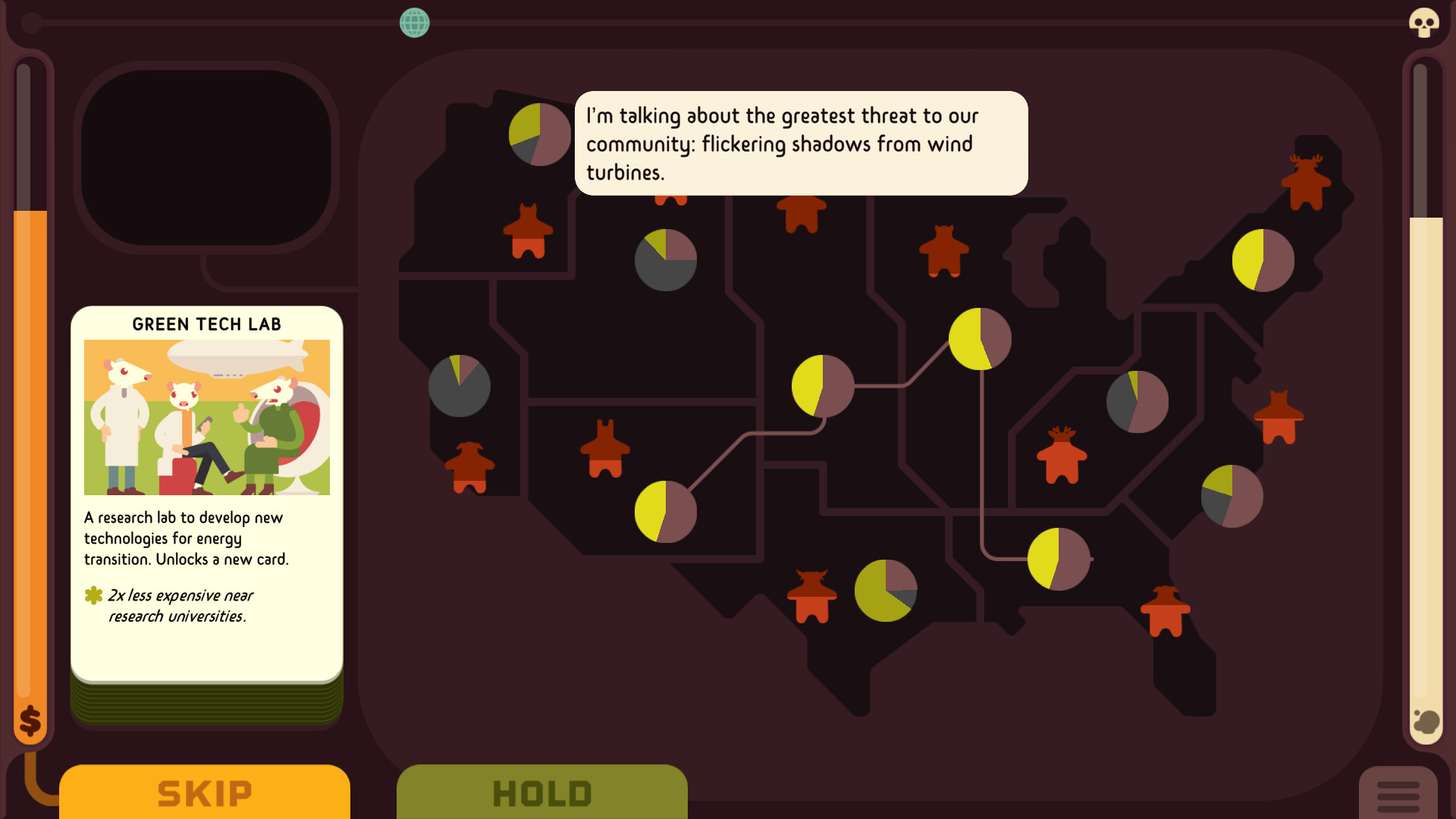
The gameplay is more complex (and less proven) than the Democratic Socialism Simulator, incorporating a map, a bit of deck-building, and a few more moving parts.
While the DSS was primarily about what reforms we should enact, the GND Simulator is more concerned with where the investments should go.
Rural regions, in particular in non-coastal and southern states, will play an outsized role in the energy transition due to their higher potential for renewables. This presents a challenge because they are the least progressive (i.e. Republican) areas in the current political terrain.
This challenge can be turned into an opportunity to achieve consensus on climate issues, because a green transition means jobs and state-driven development in regions ravaged by neoliberal policies.
Therefore, negotiating employment and emission reduction goals is a core mechanic in the game, reflecting a central tenet of the Green New Deal.
Another important design choice was the differentiation between fossil fuels for electric power generation, and fuels for heating and transportation (gasoline and natural gas). This is the aspect that confused my playtesters the most, but it’s a crucial communication goal: you don’t save the world by driving an electric car if the electricity is created by burning fossil fuels. Conversely, transitioning the grid to wind and solar won’t automatically take care of a big chunk of emissions that are not related to electricity. I hope to convey that electrification and the development of renewables are interrelated but distinct problems.
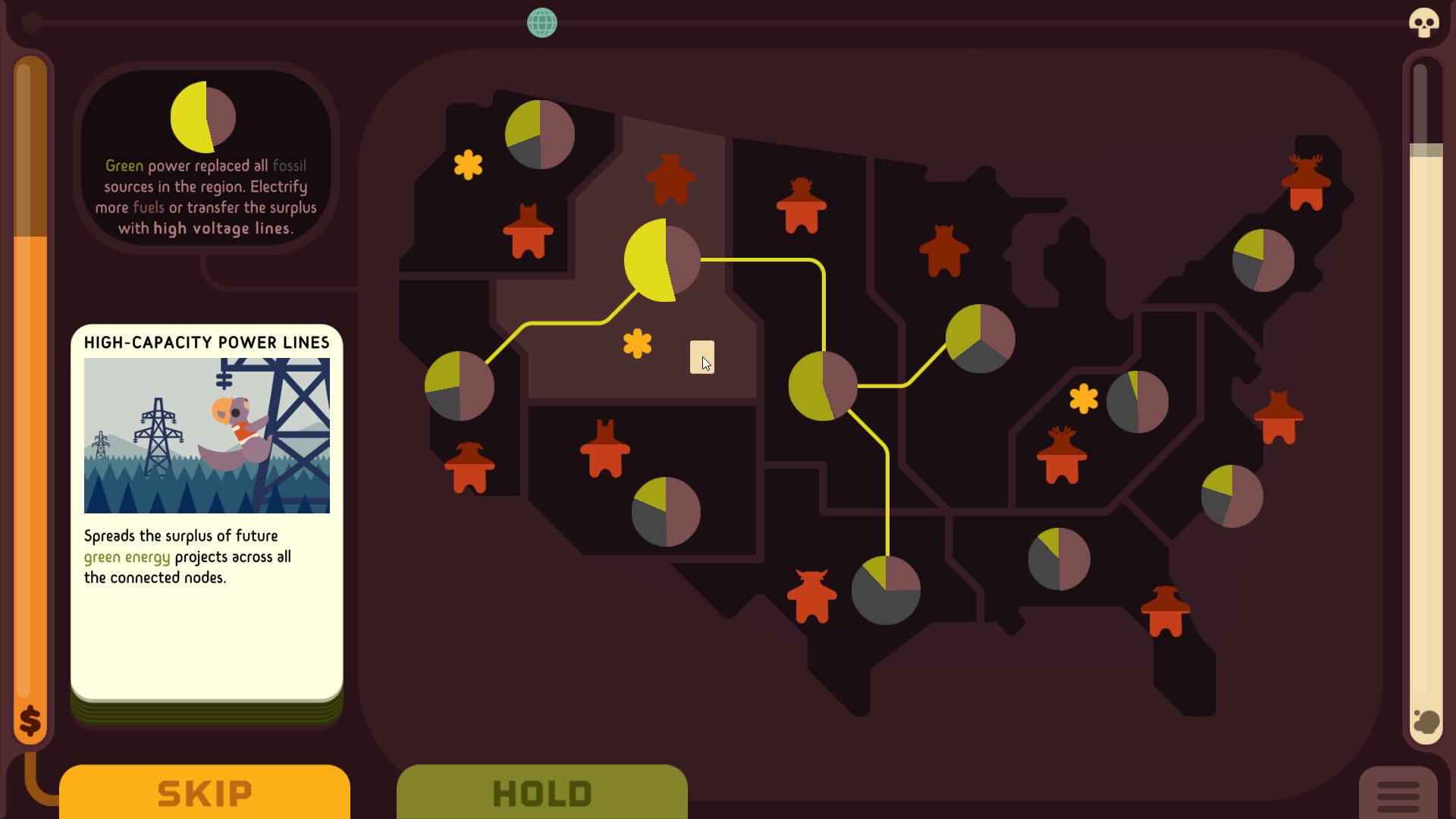
I also wanted to communicate the importance of energy infrastructure. The highest potential for renewables is in sunny deserts or windy mountainous regions. That’s not where most Americans live! Transferring massive amounts of energy across the United States will require high voltage power lines that are simply not there yet. In order to make intermittent sources like solar or wind more reliable we will need pumped storage hydropower, batteries, and more sophisticated “smart” grids. Infrastructure is less photogenic than wind turbines and electric cars, but it will be a major aspect of the energy transition.
A design pillar very dear to me is “No Exposed Numbers”. All the quantities in the game are expressed visually through bars and charts. This strategic vagueness is meant to encourage a more qualitative approach to the issues.
There is some research informing the variables and the algorithms in the game, but any game model will have to resort to gross simplifications to be even vaguely playable.
The use of “simulator” in the title is in line with the ironic contemporary usage, as in: Goat Simulator. I want people to keep in mind that this is fundamentally a fable with talking animals, an interactive toy, and not a scientific model. I maintain that all games claiming to be realistic, or based on real data are misleading their players. When it comes to complex systems, realism is just an aesthetic.
Since the map is fixed and the cards are limited, the GND Simulator may have a puzzle-like vibe, but there are multiple pathways to decarbonization. There is also no silver bullet: you cannot win by only using nuclear power or carbon capture.
There are so many aspects of the energy transition I couldn’t fit into the game. That’s the downside of making a small, minimalistic game about the most complex challenge the human race has ever faced.
I Created the Perfect Society in Crusader Kings III
A 5 minute video about testing the limits of the critically acclaimed medieval strategy game.
Can you replace nobles with republics, dismantle the papacy, and create an ecofeminist society in the AD 1200?
Yes, yes, and yes.
El Problema es el Capitalismo: the Game

Rules:
1. Start from a random Wikipedia article
http://en.wikipedia.org/wiki/Special:Random
2. Click on the link that might take you closer to the “Capitalism” page
3. Repeat 2 until you get to “Capitalism”
Each click = 1 point. The player with the lowest score wins.
Variants / house rules:
*A page mentioning capitalism counts even without the link.
*Avoid the United States of America page (too easy).
*Speedrun: keep track of time instead of links/points.
*Single player: get to capitalism in less than 5 links.
Gone with a Flash (talk transcript)

This is the transcript of an artist talk I gave about the end-of-life of Adobe Flash, and digital art preservation in general. It was part of “Gone in a Flash”, a series of events organized by the MacKenzie Art Gallery and Neutral Ground Artist Run Centre. You can also watch the video here or check the slides here.
Games Without Players
Rules & Roberts – release notes
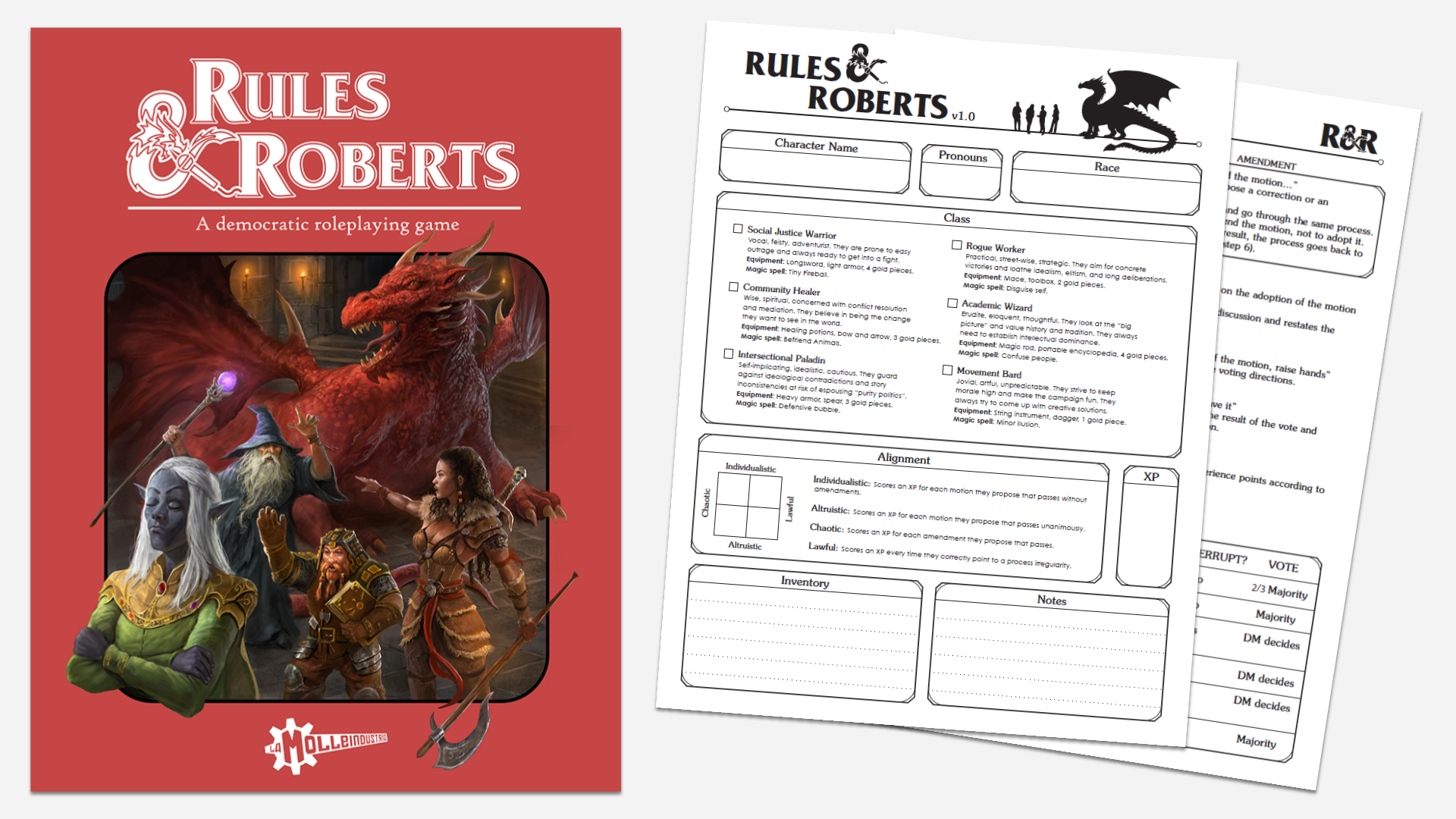
Rules & Roberts is a print-and-play educational roleplaying game to learn Robert’s Rule of Order.
Even if it’s a spoof of Dungeons & Dragons, R&R is more of a storytelling game: it’s light on mechanics, there are no dice rolls or complex stats, and the Dungeon Master doesn’t have to prepare any material nor read lengthy manuals.
The players act as a group of adventures determined to bring justice, peace and freedom in a high fantasy universe. Being a radically democratic group, all of their actions are methodically debated and agreed upon. The starter campaigns have not-so-subtle social justice allegories and the whole ruleset is meant to temper some of the most regressive aspects of fantasy settings.
The main gameplay feature is related to decision making. Instead of individualistically declaring their actions, or planning the next move informally, each player proposes motions that are discussed, amended, and approved by the whole group following the Robert’s Rules of Order process. Unlike traditional tabletop roleplaying games, Rules & Roberts can be effectively played by any number of people.
Here’s a gameplay sample:
Dungeon Master (DM): After traversing the Swamp of Sadness you arrive, still teary eyed, to the entrance of a dungeon. It’s located amidst overgrown ruins. Riotous cries come from deep inside, a stench of neglect wafts to the surface. Down the road to the west you see the smoking chimneys of a small village.
Jason: Does the village look human?
DM: It’s certainly human-made architecture.
Kate: Does my character, being an academic wizard, know anything about the dungeon?
DM: You recall reading about this place. It used to be a magnificent castle, but after an economic downturn it was abandoned and fell into disrepair. Only the underground dungeons are still used as prisons. The crisis likely increased crime and incarceration.
Michael (playing as Aroris): I want to explore the dungeon!
DM: That would be an action to be introduced as a motion.
Michael (playing as Aroris): I move to enter the dungeon.
Laura (playing as Xyrra): Second.
DM: It is moved that the party enters the dungeon. Aroris, you can start the debate.
Michael (playing as Aroris): First, I don’t like prisons and I want to make sure nobody is unjustly incarcerated here. Second, dungeons often contain treasures and exciting adventures.
Jason (playing as Jasonir): I agree but I’d rather stop by the village first. We will check with the local community and maybe find some proper equipment.
Laura (playing as Xyrra): The cries and the lack of guards make me think there is some trouble happening now.
Kate (playing as Kelfir): I move to amend the motion. We enter the dungeon and only look for a guard or a prisoner to talk to.
Laura (playing as Xyrra): Second.
DM: Are there any objections to the amendment? …The amendment carries. The motion is now to enter the dungeon with the sole intention of talking to its inhabitants. We are back to the discussion.
Jason (playing as Jasonir): We all know that once we enter it, we’ll run into troubles. It’s problematic to parachute into a community, trying to bring justice without having any clue.
DM: If there aren’t any more contributions we can close the debate. The question is on the adoption of the motion to enter the dungeon and talk with somebody.
Those in favor of the motion, raise hands. Three.
Those opposed, raise hands. One.
You may score your Experience Points.
The dungeon is an unlit tunnel of about ten by ten feet. Nobody is around and the turmoil is getting louder. Your eyes are still adjusting to the dark when you hear a rattling noise followed by a loud thump. A heavy metal portcullis has been shut behind you.
Jason (playing as Jasonir): I told you.
Laura (playing as Xyrra): What’s a portcullis?

Robert’s Rules of Order is a manual establishing parliamentary procedures for large assemblies. It’s used by nonprofit associations, political groups, academic bodies, church groups, and trade unions, primarily in the United States.
In my experience, it works reasonably well as a system to speak in turns and structure discussions in large meetings; but being originally conceived in the late 19th century, it may appear formulaic and inaccessible to the uninitiated. People with less experience with the procedures may feel inhibited to participate; malicious individuals may use their knowledge to stall a process; less engaged members may see the whole deal as unnecessarily bureaucratic.
Rules & Roberts (the game) embraces the messiness of democratic decision making and allows mischievous lawyering, or accidental self-sabotage. It provides rather flexible rules to determine when a motion has to be proposed, and how precise it’s supposed to be. A process may spiral into recursive Kafkian amendments about the most insignificant details, or consensus may be reached swiftly for fear of lengthy discussions. Ultimately, the game is about negotiating the overhead of any democratic process, and getting acquainted to people’s different attitudes toward rule systems.
R&R started as a joke during a particularly convoluted DSA meeting, and it’s meant to be a bit of a cursed artifact to both behold, dread, and never EVER play. But it is a functioning educational game: players do get better at following Robert’s Rules of Order. I don’t know if games can actually teach anything about the world, but by playing games you certainly learn their rules. So if the rules happen to be the educational content, there you go!
Rules & Roberts is available on itch.io as name your own price
TweeVee / Interactive Movies
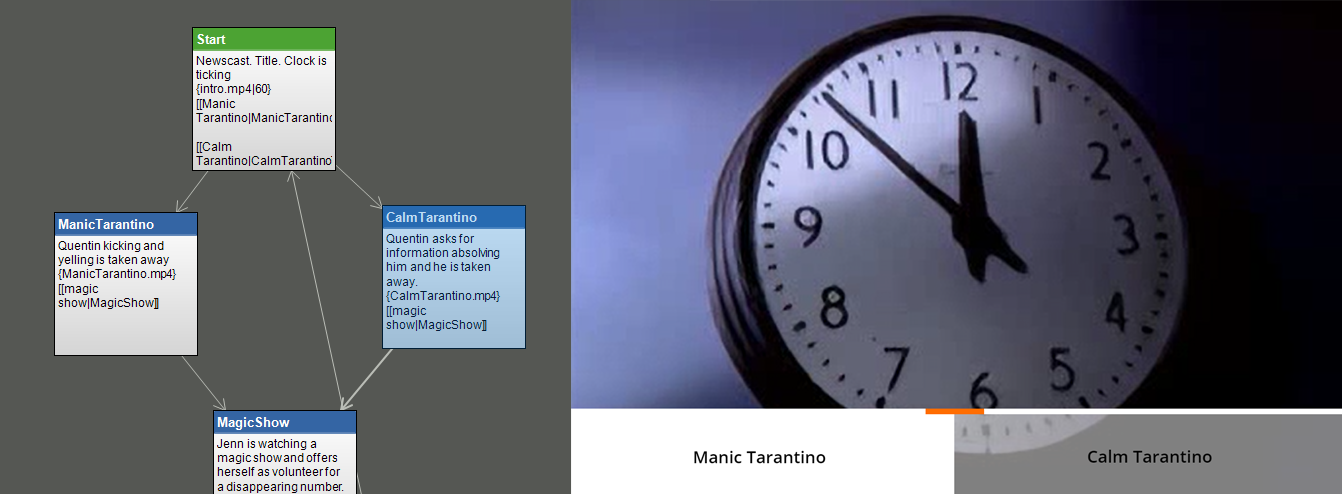
TweeVee is an engine for interactive videos built in javascript. You can create a branching movie in the style of Black Mirror: Bandersnatch starting from Twee files exported from the popular hypertext editor Twine.
TweeVee was created for a LIKELIKE livestream showcasing four interactive movies, from the pioneering Kinoautomat to the wild YouTube game The Immoral Ms. Conduct.
It was a good excuse to restore the first (American) interactive movie I’m Your Man in all of its branching splendor, and make a new piece remixing very pixelated footage from an old CD-ROM.
I’m Your Man

I’m Your Man is a 1992 short film created to showcase Loews Theatres’ interactive cinema technology. Audiences used seat-mounted joysticks to vote between three options at various point of the movie.
Although the format ultimately failed due to lack of marketing and poor audience reception, I’m Your Man was released on DVD in 1998 as part of a second attempt at interactive video.
The use of unconventional menus makes the DVD almost impossible to experience on modern computers.
Steven Spielberg’s Director’s Choices

In 1996, Knowledge Adventure and Dreamworks published Steven Spielberg’s Director’s Chair, an ambitious game simulating the process of moviemaking. The centerpiece of the title was a short film with an all star cast directed by Steven Spielberg himself.
Since the player could take some crucial decisions in the pre-production phase, the film was shot with different plot points and tonal variants.
We salvaged the game’s raw footage and reorganized it as a real time interactive movie experience. Be prepared to choose your own path through this obscure bit of film and video game history…
Two Hundred Fifty Things a Game Designer Should Know
In 2018, architecture critic Michael Sorkin wrote “Two Hundred Fifty Things an Architect Should Know”. The items on the listicle are poetic, thought provoking, introspective, practical, and sometimes even canonical. They all connect architecture with broader social issues.
In July 2020, four months after Sorkin’s death due to COVID-19, I challenged my Twitter friends and aquaintances to come up with a similar list for the discipline of game design. Primarily I hoped to compile a little icebreaker for game design students, but I realized it’s also a kind of snapshot of contemporary critical issues in games that are deeply felt but not common sense yet: player-centered design, accessibility, work-life balance, need for more diversity etc.
Twitch Plays Bees / Twitch Plays Everything / Twitch Plays MIDI
This Fall, due to COVID-19, I’m teaching a class about online multiplayer games. It’s a great excuse to learn new skills and run some little experiments in these long, socially distanced days. As class material, I put together two Processing templates to facilitate Twitch-powered multiplayer experiences. Every Twitch channel comes with an IRC chat and it has been used, most notably by Twitch Plays Pokemon, to create interactive live streams.
TwitchPlaysEverything (github source) is a generalized template that turns chat commands into system inputs (mouse and keyboard). I used it quite successfully to let users play the cult AI drama Façade, the game doesn’t rely on quick reactions and it’s based on natural language input. Unfortunately but predictably, the random Twitch users simply ended up trolling and flirting with the AI characters, which is not the most interesting way to play the game.
TwitchToMIDI (github source) lets Twitch users control a MIDI channel on your computer. The setup is a bit complex and it requires some kind of DAW but I can see it potentially used to spice up live DJ set or live-coding performances online.
The code was used for two Twitch Plays Bees streams (video documentation above), in which users made drone music from the sound of my beehive in real time. They controlled the knobs of two filters through chat commands like “mix 100 10” (turn the controller labeled “mix” to 100% over 10 seconds). In the second stream the hive was quite noise since it’s was being attacked by robber bees from another colony. It made for a more interesting sound texture and a more exciting live stream.
MUDlike / The end of the WORD as we know it
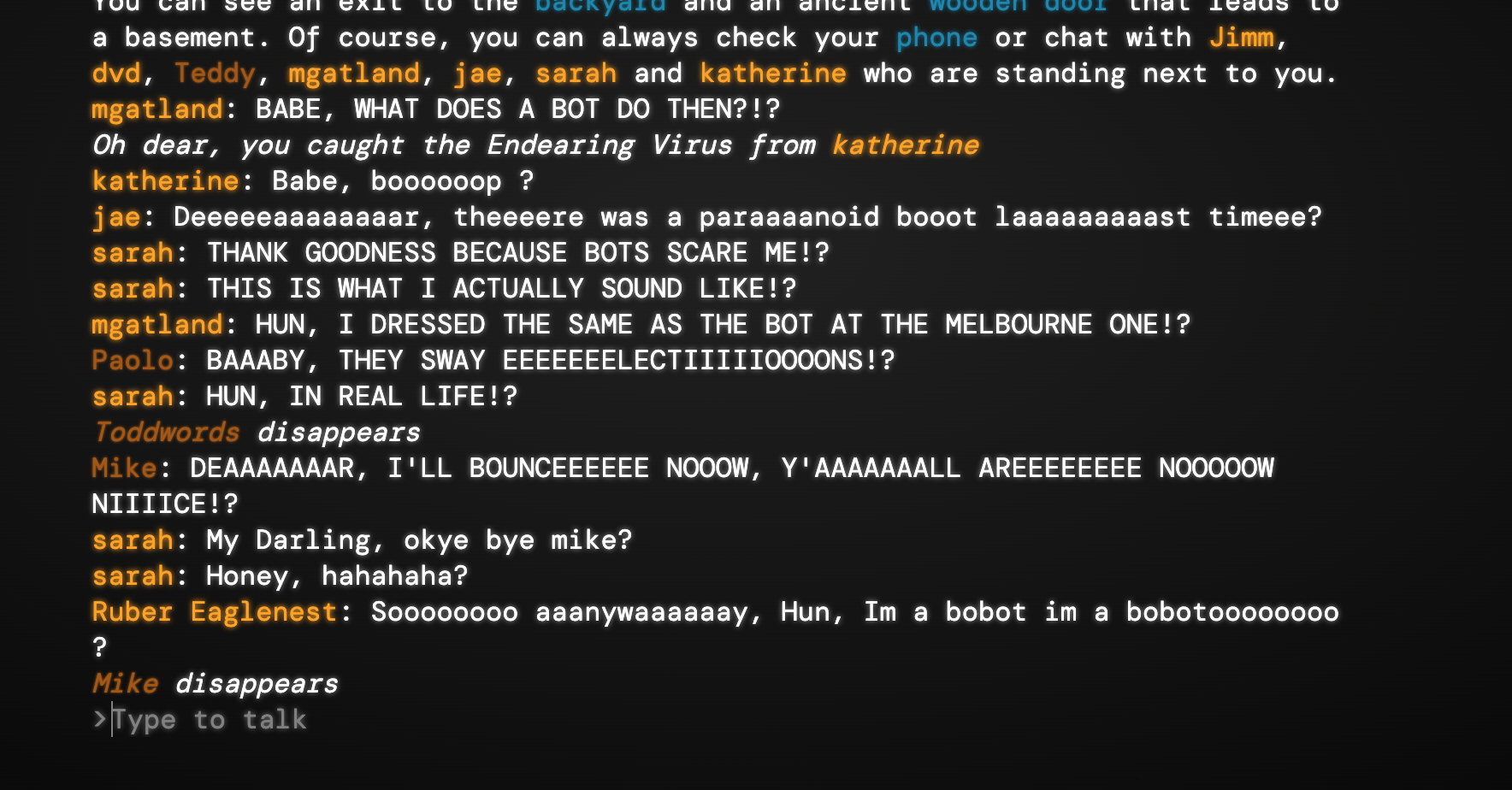
The third iteration of LIKELIKE Online is a text-only multiuser environment for the exhibition The End of the WORD as we know it. In this Twine-meets-chatroom, you can catch language viruses from other uses. The viruses affect your way of speaking making you siiiiing, SCREAM, or adding other funny affectations. The six curated games are hidden/integrated in the text environment and playable online. The exhibition opening turned out to be quite chaotic and not as easy to navigate as the visual counterpart due to the inherent conflict between real time interaction and linear texts.
The engine is quite sophisticated: it parses a Twine file and uses it as the main hypertext. A series of custom macros can be added to manifest the current state of the various players. It’s not very pleasant to write for it but it can potentially be used to create multi-user text environments, escape the rooms, or parser-less MUDs so I cleaned it up a little and made it open source:
LIKELIKE Online / oMoMA
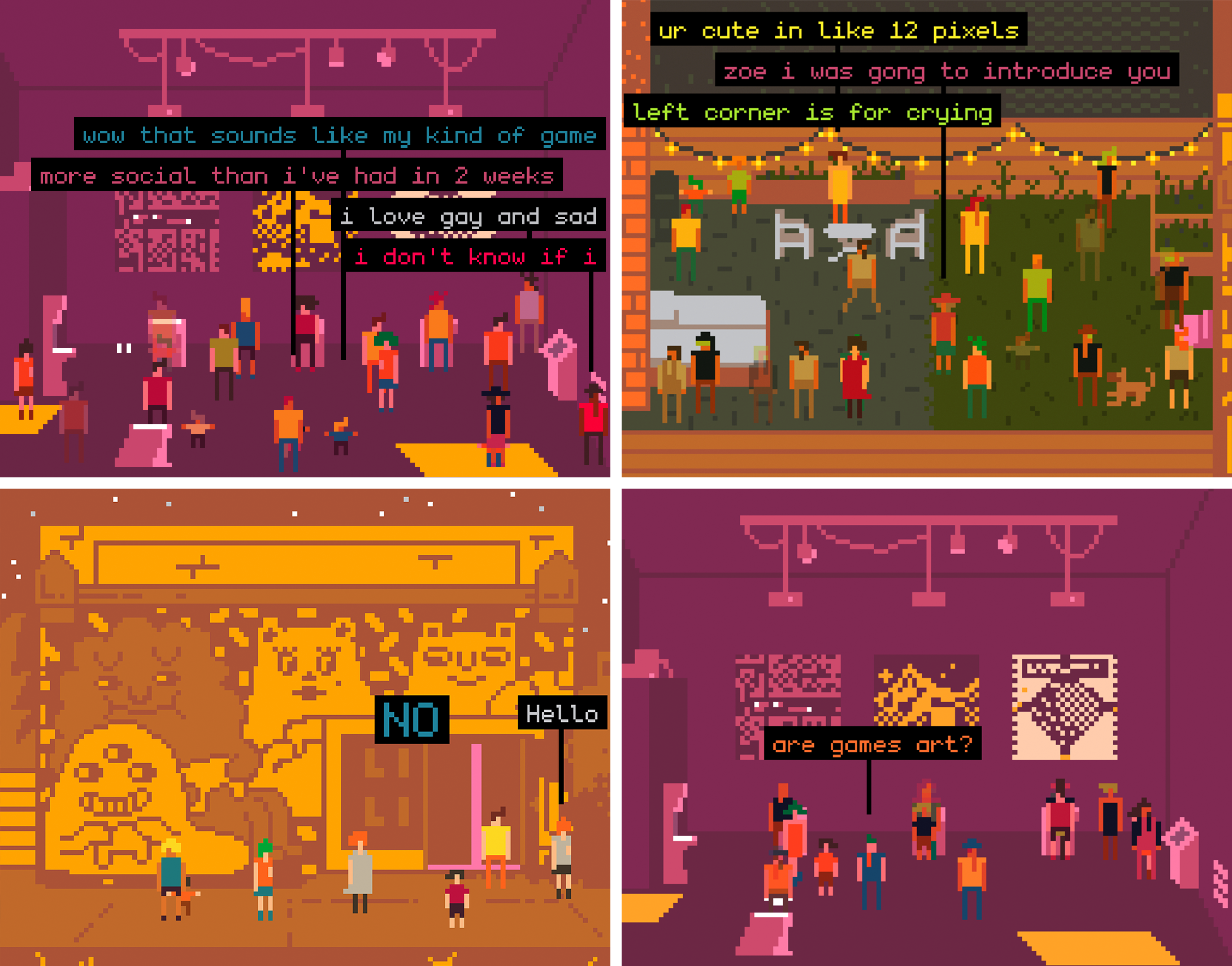
LIKELIKE, the little game space I run with some friends in Pittsburgh, suspended all programming due to COVID-19. The pandemic is going to have long lasting impacts on the world economy; millions of Americans are suddenly unemployed and entire industries came to a standstill. It’s not a great time for event organizers, but in gaming and art+tech communities we are relatively lucky due to our familiarity with remote practices. While normies scramble to set up Zoom accounts, many of us have been involved with streaming culture or online games for a long time, and embraced extremely online, borderline hikikomori lifestyles even before the quarantine. So it’s not surprising to see game people already experimenting with social distanced formats in education and art events.
I fundamentally loathe the now pervasive wecam aesthetic, so I decided to create a low-res multiplayer environment that attempts to capture some of the social component of LIKELIKE events. LIKELIKE Online is the most literal MMORPG ever: you dress up, check some games, and chat with friends and strangers in a small space. The opening night was loud and crowded, on weekdays it’s more chill and gallery-like. There is really not much to do and the conversations, mostly small talk, have an early-internet chatroom quality.
All the exhibited games are made in bitsy, and more or less obliquely deal with the theme of crisis. Bitsy games tend to be quiet and intimate, and can be challenging to play at noisy events, so this was a good chance to show something that wouldn’t quite fit in the physical space.

Two weeks after the opening, LIKELIKE Online “gentrified” and opened a new wing: the online Museum of Multiplayer Art. The oMoMa is made of nine playful environments that, quoting the press release “interrogate our notions of mediated sociality and digital embodiment. The virtual installations, operating at the intersection of art and technology, draw from the tradition of experimental chats, net.art, conceptual language games, and online roleplaying worlds.”.
The oMoMA is a both a tongue-in-cheek response to the forced virtualization of the art world under COVID-19, and a contribution to the genre of virtual museums. Virtual museums generally transpose all the signifiers of modern art institutions (white walls, architectural extravagance, overwrought curatorial statements, monumental installations…) into 3D game engines. Whether solo efforts or collaborative endeavor, they tend to be made of mostly static, non-interactive environments – the implication being that art is something to look at, or to walk through.
With the oMoMA I wanted to create playful spaces that reproduce the social dynamics of exhibition spaces while leveraging the peculiarity of mediated spaces. There is not much to see at the oMoMA: all the installations require having conversations with other users. Some “pieces” go entirely unnoticed by lonely or shy visitors.
Most of the rooms encourage subversive play and revolve around client-server power relations. Whereas traditional multiplayer games attempt to distribute an “objective” reality to all players, the oMoMA plays tricks on its visitors, manipulating what they say or how they look.

The oMoMA was also an excuse to add a series of modding features to the original codebase. It is now possible to add room-specific behaviors on both server and client side without touching the engine.
LIKELIKE Online is open source and easily remixable on the Glitch platform. You can create your own little spaces or use it as a template for online games and multi-user environments.
Source on github
Project
Democratic Socialism Simulator – Release Notes
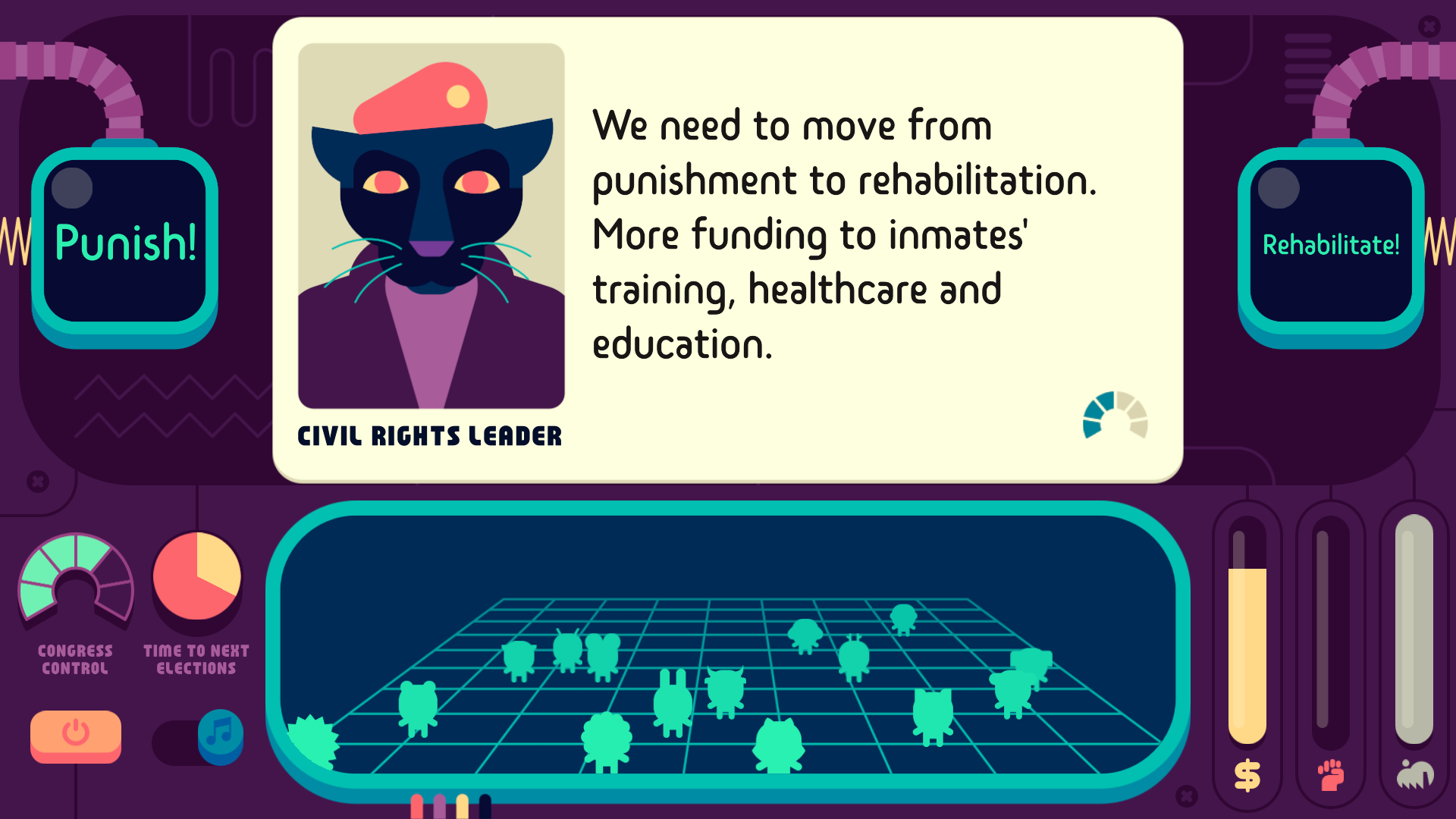
Democratic Socialism Simulator was released yesterday for Windows, MacOS, and Linux. The Android version is still under review. It’s a casual, single player game in which you play as the first socialist president of the United States. You have to evaluate an endless stream of policy proposals, balance the budget, reduce greenhouse gas emissions, gain the support of different voters and build people’s power.
The title Democratic Socialism Simulator is a bit of a misnomer since the game doesn’t portray a democratic socialist society but rather the first years of a hypothetical post-capitalist transition via social democracy. I have made a few prototypes that modeled a democratic socialist economy but, at least as single player experiences, they didn’t differ too much from traditional resource management games. I thought the very beginning of such a transformation would make for a more interesting and timely subject.
In other words, DSS is an attempt to prefigure a Sanders (or a Sanders-like) presidency by focusing on the issues not fanboyism. Most of the proposals are lifted straight from Bernie Sanders’ platform so you can see it as an interactive flyer of some sort.
DSS borrows its gameplay from the game Reigns (which in turn, borrows its interface from the dating app Tinder). It’s a simple but infinitely expandable structure that can touch upon a lot of topics with very little audiovisual content. Aside from being particularly satisfying on touch screens, the swiping mechanic is a clever way to present a lot of variables and effects to the player. Dragging a proposal left and right visualizes its most immediate effects without cluttering the interface.
In Reigns you play as king or queen, going through a series of grievances from your subjects. Your goal is to stay in power as long as possible by not alienating (or favoring too much) the Church, the people, the army, and the treasury. This kind of agency is appropriate for a feudal setting but it doesn’t work in a game set in a liberal democracy, and in which the goal is to change the status quo.
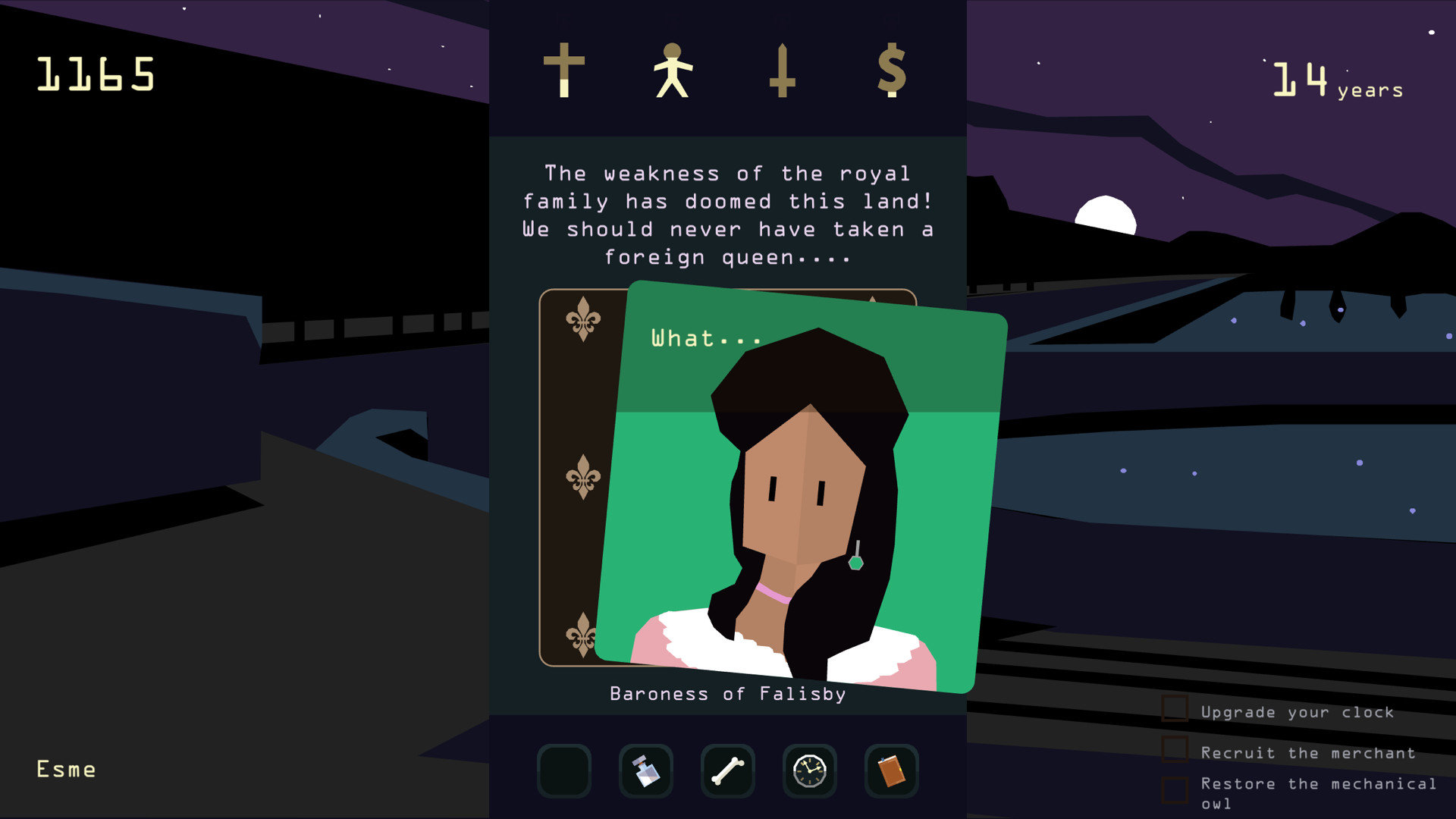
In DSS your actions are attributed to the coalition supporting the president. The congress counter represents not only the seats held by the Democratic party but also the forces that actually support you across institutions and in the civil society. Some radical reforms require a minimum of support to be enacted. Your presidency is obviously limited to two terms with the possibility of losing the reelection.
The voters’ approval depends on their top two issues, and this is a crucial feature. In a time of polarization and tribalism, it’s easy to forget that the ideological alignment of most Americans is more complex, contradictory, and multidimensional than what the media portrays. We are tempted to conceptualize voters as standing on an axis going from “very liberal” to “very conservative”, a gradient of blue and red. That’s a simplification that favors a centrist view: since the left and right wings are assumed to be already politically engaged, the only way to expand support is to appeal to the moderate center. In reality there is evidence showing that swing voters can hold very progressive and very conservative positions at the same time, and that non-voters are all across the ideological spectrum. I believe this multidimensional model of affiliation is fundamental to create working class coalitions in the USA and abroad. Moreover, in DSS the electorate’s composition and top priorities can change as a result of your reforms.
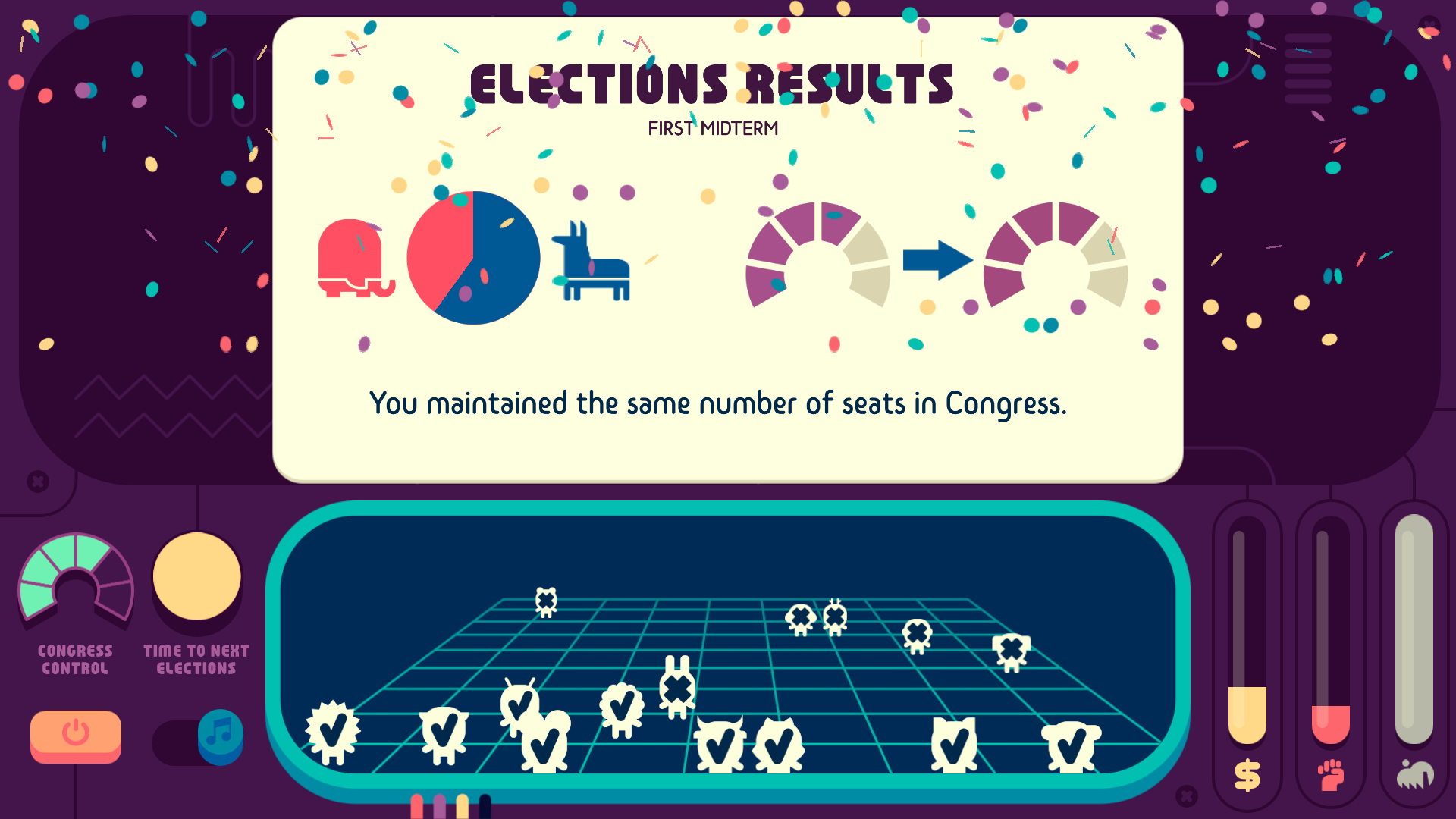
But DSS is not just a power fantasy for leftists. The game speculates about the challenges to radical reforms that could come from the ruling class, Wall Street, mainstream media, deep state, and corporate Democrats. While the polls show that proposals like the Green New Deal or Medicare For All are extremely popular, the general public may not be prepared to even conceptualize the opposition that they would inevitably encounter.
The latest issue of Jacobin is entirely devoted to democratic socialist horror stories. The capitalists may be irrelevant in numeric terms, but they have an enormous leverage over “the economy” and the state apparatuses. They can collectively withdraw investments and use their media to frame the subsequent crisis as a political failure. They can outright buy politicians’ support. They can exercise their clout over liberal elites. The left in the United States has been marginal for so long that any conversation about what can possibly happen once in power has become irrelevant. The neoliberal/technocratic vision of politics still dominates the Democratic base, and the idea of a continuous mobilization and pressure campaign after winning the elections is unheard of.
As the perspective of a democratic socialist turn becomes more concrete, we need to create culture that both expands the realm of the possible, and prepares us for the struggles ahead. Change may be scary, but no change at all is much scarier.

DSS has not been designed to mount a precise linear argument. It has different endings and a specific starting point (you have a mandate) but it doesn’t prescribe a “correct” path to socialism. Instead it’s more like a collection of semi-random choices, conditions, and cause-and-effect relations that interact with each other in a messy way, creating a multitude of possible paths. Players can define their own idea of success: they can play as cautious moderates, or even enact some markedly right-wing policies (deportations, privatizations, austerity, militarism).
Games that try to embed their politics deep into their gameplay are still relatively rare. In my experience, many players expect a clearly delivered “message” and try to extract it from a single play-through. DSS has a significant element of randomness and a number of implicit mechanics that the player can only guess, so I wouldn’t be surprised if different people come up with widely divergent interpretations. Without getting too much into semiotics, what the game “says” about socialism is a network of micro arguments explorable in a variety of directions. The *ideological engine* of the game is basically a series of spreadsheets that I share here for the most curious and nerdy users. There is even a column with notes and links related to the specific proposal and event.
THE COMPLETE DEMOCRATIC SOCIALISM SIMULATOR SPREADSHEET (spoilers)
Notes: The data should be rather self explanatory. The “equality” variable is the “people’s power” red bar. The command “chain” stacks a card right after the current one. The command “delay” postpones an event after a random number of cards within certain intervals.
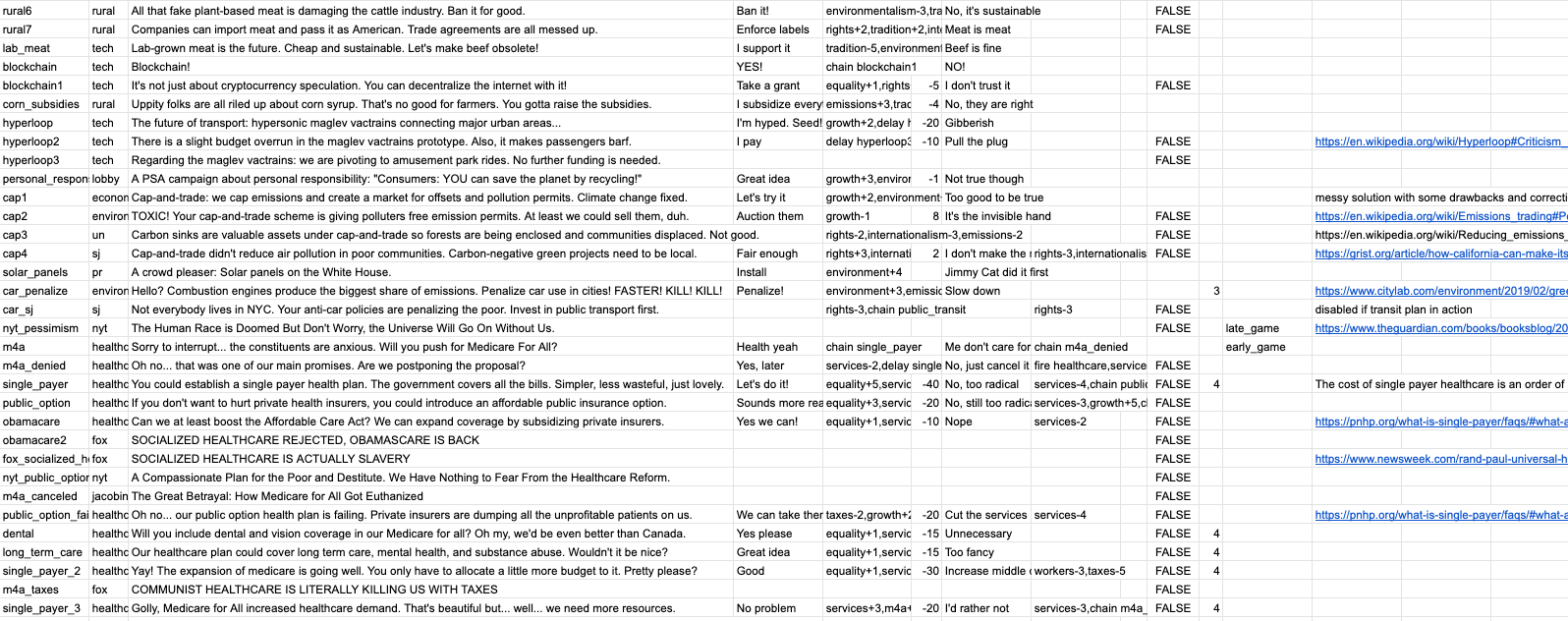
Democratic Socialist Simulator is not free. After 17 years of Molleindustria, it is the first proper commercial release. I’m already getting some comments like “iF iTs SoCiaLIsT wHy IsNT iT fREe??”. There are a couple of reasons:
1) Pretty much nobody cares about free games today. Websites don’t review them, stores have no interest in featuring them. There are hundreds of indie games coming out every day. Many of these releases are student projects, prototypes, half finished jam games, joke games, zine games, sketchy asset flips. It’s wonderful to see such a democratization of the form, but I’m afraid not putting a price on a game is increasingly seen as not attributing any value to it.
2) During the Flash era, free online games could reach a potentially huge audience. Some Molleindustria games racked up millions of plays. It meant connecting with people outside my filter bubble and challenging them with naughty anticapitalist games. To some extent, Democratic Socialist Simulator is meant to preach to the choir (although it’s a rapidly growing choir); it’s less “Wake up sheeple!” and more “What is to be done?” so I’m fine if the price tag pre-selects the audience.
3) Free games cannot be used for fundraising purposes. In recent years we’ve seen a multitude of game bundles put together to support good causes. Since all my games were free I had nothing to contribute, and that bothered me a lot.
Of course if you are a broke comrade, feel free to contact me, and I’ll send you a download code.
Molleindustria’s Highlights from 2019
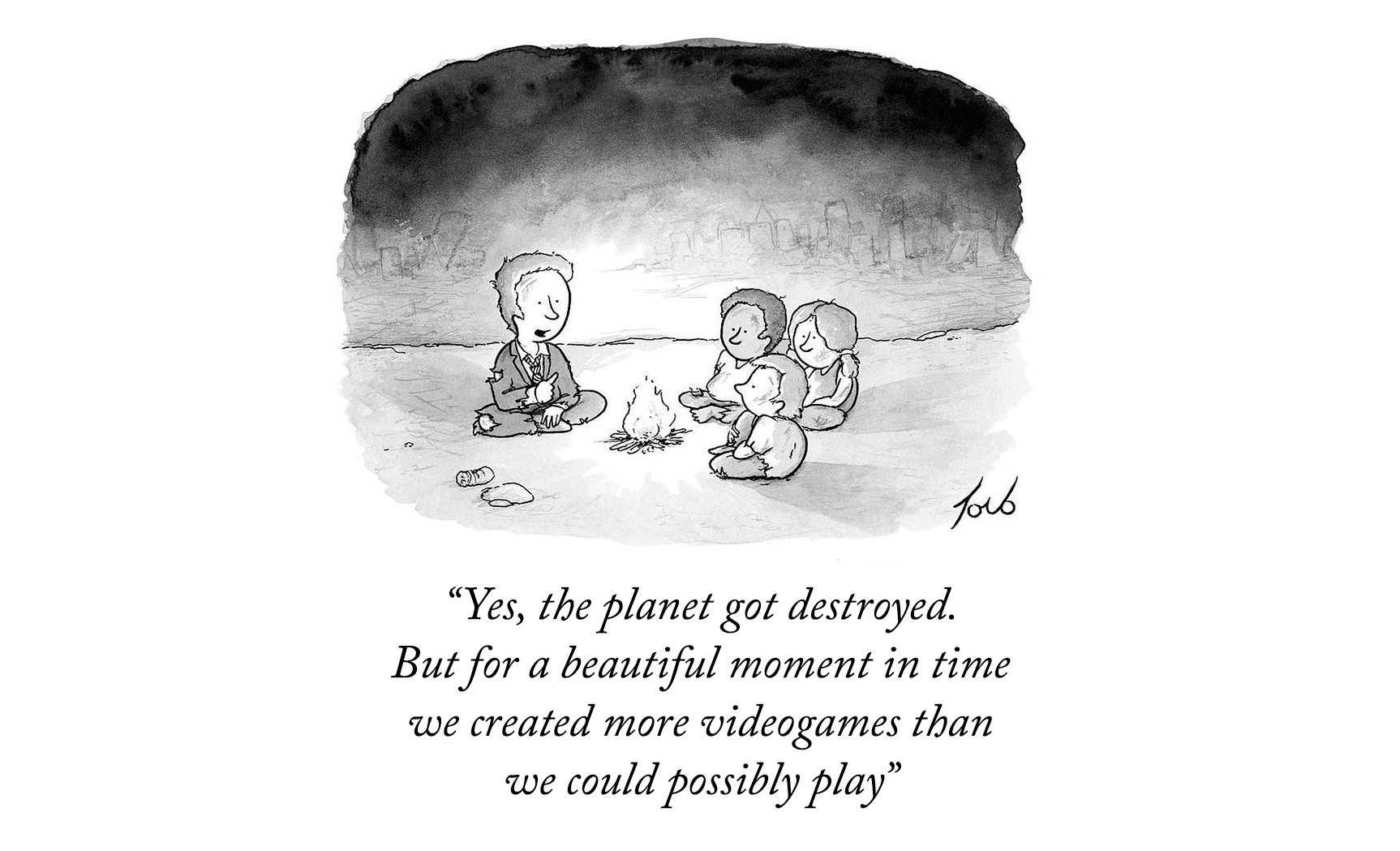
After a couple of Indiepocalyptic years, in 2019 we finally reached the Sindielarity: the moment in which indie releases outpaced the capacity of both primary audiences and tastemakers to process them. The sheer number of high profile games is unprecedented. Multi-year projects by well respected developers merely break through the noise, hidden gems (presumably) remain hidden.
It is possible that large audiences aren’t even necessary in this particular conjuncture since commercial developers are increasingly funded by exclusive deals with distribution platforms. In the war to become the Netflix of Videogames, indies are instrumental to the capture of lifetime users. They are the cheapest way for the digital rentiers to say “join us, we have lots and lots of content you can’t find anywhere else”. Like TV after Netflix, the positive side effect may be a deluge of edgy products that would otherwise be financially risky.
Do Best-of-the-Year lists even make sense in these post-discoverability times?
I suspect I’ll keep finding great games I missed in 2019 for a while. With this disclaimer, here’s the ones I played and liked. Briefer comments than usual because the games are many.
In no particular order:
CAN YOU BE LIKE LIKELIKE?
Can you run a pop-up arcade in your spare time? And if so why would you?
A short talk about LIKELIKE I gave at the first Game Arts International Assembly (GAIA), a gathering of game curators and event organizers in Buenos Aires.
It’s about game curation from a perspective of a practitioner and about reducing work as much as possible.
Every bee videogame reviewed by accuracy
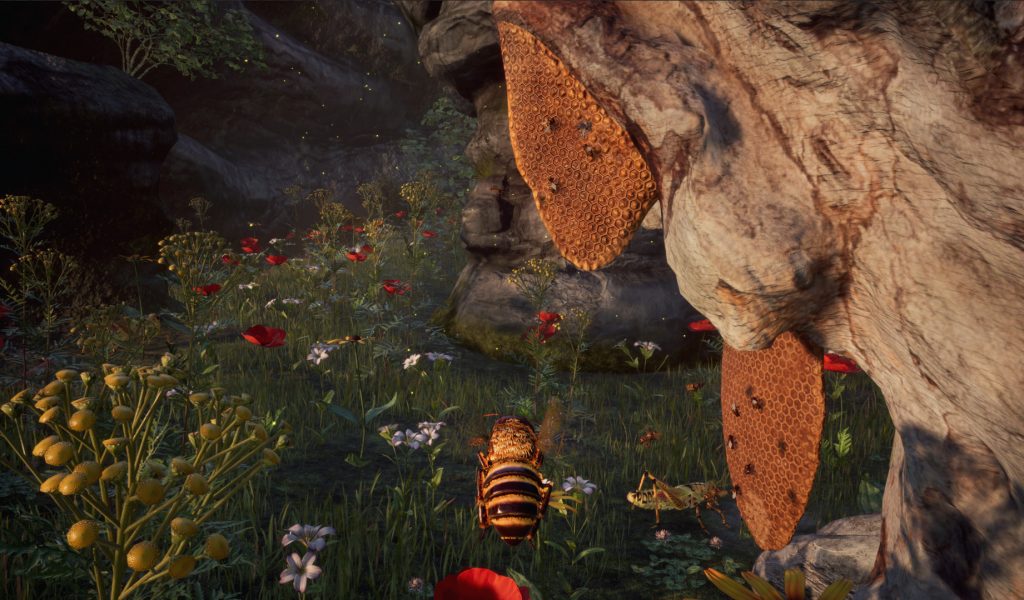
Bees, particularly honeybees, are often incorrectly characterized in videogames – as well as in other media. Sometimes that’s due to their similarity with with the more aggressive wasps (which make for better enemies), sometimes that is due to the alien-like complexity of their social behavior, sometimes the creators are interested in bees only beecause they allow a multitude of puns around on the letter B. Hilarious.
The threat of Colony Collapse Disorder and the alarming decline of wild bee species has brought an unprecedented mainstream interest around the fuzzy pollinators, which in turn spurred a wave of bee-themed indie games. As an amateur beekeeper, semi-professional game designer, and generally pedantic person, I decided to play all the games I could find on the subject and rate them according to their “realism”. The rating goes from one (⬢⬡⬡⬡⬡) to five (⬢⬢⬢⬢⬢) honeycomb cells.
I intentionally avoided all the games in which bees are completely anthropomorphized or function like a spaceship, and games in which bees play a secondary role. I did include short and semi-abstract games when they referenced the bees actual behavior. Realism is not a matter of visual definition or sheer procedural complexity. In my view, even a tiny game can capture something compelling about this fascinating insect.
Site Update
This website just went through a major update! Some notable changes:
- The Flash embeds, which are now automatically blocked in most browsers, have been replaced with short gameplay videos. The games are still playable via browser following a link and the downloadable buttons are more prominent.
- The English translations in some old games have been improved along with some non-standard control layouts.
- All the games have been updated to 64bit and the Mac versions have been notarized , so they should survive the mass extinction that MacOS Catalina will inevitably trigger
- Most pages have responsive templates and should now look decent on mobile.
- The main site has an SSL certificate, whatever that means.
- Some recent projects and selected talks have been added to the homepage so you don’t have to dig in the blog to find them.
Let me know if you encounter any issues.




